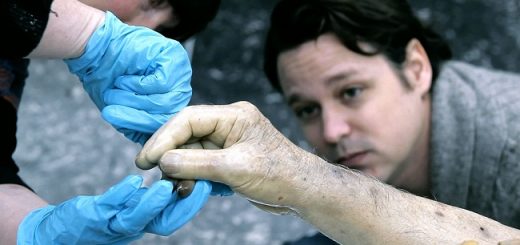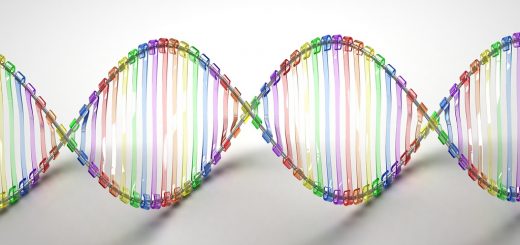Seeing Red – Presumptive Tests for Blood
Felicity Carlysle gets colourful looking at the methods used by crime scene investigators to detect blood.
It is a classic scene: a room seemingly clean is shown to be in fact splattered in blood, all thanks to a magic spray and some ultraviolet light. So what is this magical spray, and does it really work?
Luminol
Generally when a spray is used to detect blood, the chemical used is called Luminol. Luminol (or 3-aminophthalhydrazine1) will give off a blue light when in the presence of an oxidising agent such as hydrogen peroxide. However, in order to produce a substantial amount of visible light a catalyst is required2. One such catalyst is iron, and therefore if Luminol and hydrogen peroxide come into contact with blood the reaction will be catalysed by the iron in the haemoglobin found within red blood cells. So Luminol is pre-mixed with hydrogen peroxide in a spray ready to use at a crime scene and this is what you see being used on television.
While at first glance this seems like a fantastic solution to the problem of how to detect blood residue, there are several issues with its use. The most significant is that the reaction is not specific to blood and it will in fact emit light in the presence of a range of substances including plant materials, metals and cleaning products such as bleach. Therefore Luminol is not suitable for use at a scene where it is suspected that bleach has been used to clean the scene, and any positive result must be taken as a presumptive positive and followed up by analytical tests to confirm the presence of blood. There are also possible health hazards associated with the use of Luminol; it is a respiratory irritant, and potentially a carcinogen as well as a mutagen that could cause birth defects. This is combined with the fact that hydrogen peroxide is not a particularly pleasant compound to be spraying around (bearing in mind a potential crime scene may be someone’s home) and therefore appropriate precautions, such as wearing facemasks in addition to normal crime scene protective clothing, must be taken if Luminol is used. Low lighting levels are needed to enable the light produced by the reaction to be seen, so if the light cannot be reduced to a low enough level then Luminol cannot be used.
Despite these drawbacks, Luminol has the advantage of being very sensitive and is capable of detecting blood in as small a quantity as one part per million. Luminol is even able to detect blood on surfaces that have been painted over because the wet paint will mix with the blood (with some blood remaining even if the surface looks clean). This means that some blood will be on the top surface of the paint and, thanks to the sensitivity of Luminol, only a tiny amount of blood needs to come into contact with it for the reaction to occur. Luminol does not affect samples that are to be used for DNA analysis, however it can affect other potential chemical evidence by the introduction of hydrogen peroxide which can be quite destructive. Therefore in a real crime scene situation Luminol will only be used after all other potential evidence has been collected, and generally not sprayed in such copious amounts as seen on television.
Fluorescein
While Luminol is more commonly used, there is another chemical called Fluorescein that can be used to reveal hidden blood stains. Fluorescein has only been around since the 1990s compared to Luminol which has been known from as early as 19393. This is likely to be why Luminol is still more commonly used, despite the fact that Fluorescein will not react with household cleaning agents such as bleach.
Kastle-Meyer Colour test
The Kastle-Meyer colour test works on a similar principle to Luminol, with an active compound which reacts with hydrogen peroxide in the presence of blood. In this case the chemical involved is phenolphthalein. This will react with hydrogen peroxide in the presence of haemoglobin to produce a pink colour. The reaction can be carried out using a swab to sample the suspected blood stain, or a piece of filter paper, depending on the surface that the suspected blood is on. A few drops of phenolphthalein are applied to the sample, and after a few seconds (to ensure that the sample doesn’t turn pink without hydrogen peroxide), a few drops of hydrogen peroxide are also added and the test is positive for blood if a pink colour appears within a few minutes. The speed of this test is a major advantage, however once again the test is not specific for blood, with certain vegetables such as potatoes and horseradishes4 causing false positives. Vegetables are generally not found at crime scenes, so this cross reactivity is not likely to cause too much of a problem, but it is worth remembering if your potential murder weapon is a shovel or other gardening implement.
Leucomalachite green (LMG) and Tetramethylbenzidine (TMB)
LMG and TMB are also colour changing chemicals which react with blood to produce a green or blue-green colour respectively. LMG can be used in a similar way to the Kastle-Meyer test while TMB is impregnated on strips called Hemastix. Both produce a colour change within a very short space of time, however as with the other tests, they are also prone to false positives.
Daring to presume
All of the techniques described in this article are classed as presumptive tests. This is because they are prone to false positives so, while a negative result is assumed to mean that blood is not present, a positive result is a presumptive positive for blood and further analytical methods are required to confirm that blood is present. A negative result should be confirmed by using a positive control (for example a known blood sample) as the liquid solutions used in these presumptive tests are susceptible to degradation.
Once you have a presumptive positive for blood as well as analysis to confirm the sample is blood, you need to determine whether or not the blood is human and then you can move on to the process of attempting to discover who the blood came from.
So, magic detection sprays do exist, but sadly they do not provide all the answers that they appear to on the television. For that, more scientific analysis is required.
References
- http://nzic.org.nz/ChemProcesses/biotech/12A.pdf
- http://science.howstuffworks.com/luminol2.htm
- Fraser J, Williams R, Handbook of Forensic Science, Willan Publishing, 2009
- Lyle DP, Forensics for Dummies, Wiley, 2004











Dear Felicity,
I have a question about presumptive tests to distinguish animal from human blood. How reliable are these tests? If you could email me some advice or where to find out I’d be most grateful.
Many thanks,
Tana Adkin
Charter Chambers
Presumptive blood tests cannot determine the origin of the blood, it can only determine if the stain is most likely blood or not blood. If you get a positive result from a presumptive test and the stain appears to have the appearance of blood (i.e. red/brown) then there is another test called the ABA Hematrace test that can easily and rapidly determine whether or not the presumptive blood is of human origin. If this test is negative, then there are further immuno-diffusion tests that can identify the most-likely species of animal blood that this sample originates from.
Hope that helps.
I have a question as i am trying to outline a plot for a book (fiction, thriller crime) My idea was for the perp to use pig blood in order to make it look someone had been murdered (no body) would they be able to tell at the scene that it animal blood? Or would it need more rigorous tests? Also, if it did, how long do these tests take?
thank you!
You have my name
and job
I have a question: are there other reasons for a false positive other than some vegetables?
I have same type question as Christina on false positives. Specifically, would fecal matter produce a false positive on these tests? What would be the best test for distinguishing blood from fecal matter? (would also be curious to learn more on how florescein works) Thanks.
I have a question, why does the liquid only change into one color? and is there any other glow in the dark colors?
IF A CRIME SCENE HAPPENED IN A GARAGE 29 YEARS AGO AND HOMISIDE WENT TO THE GARAGE 29 YEARS AFTER THE CRIME IN THE DAY TIME AND SPRAYED IT WITH LUMINOL PHOTOS LOOK LIKE TERE TAKEN THEM IN THE LIGHT WOULD A PALE RED TINGE APPEAR INSTEAD OF GREENY BLUE UNDER DARK LIGHTS?
Is there any reason why Kastle Meyer field test at a crime scene would produce a positive result, but 23 years later on the same stain on the same towel would produce a negative result?